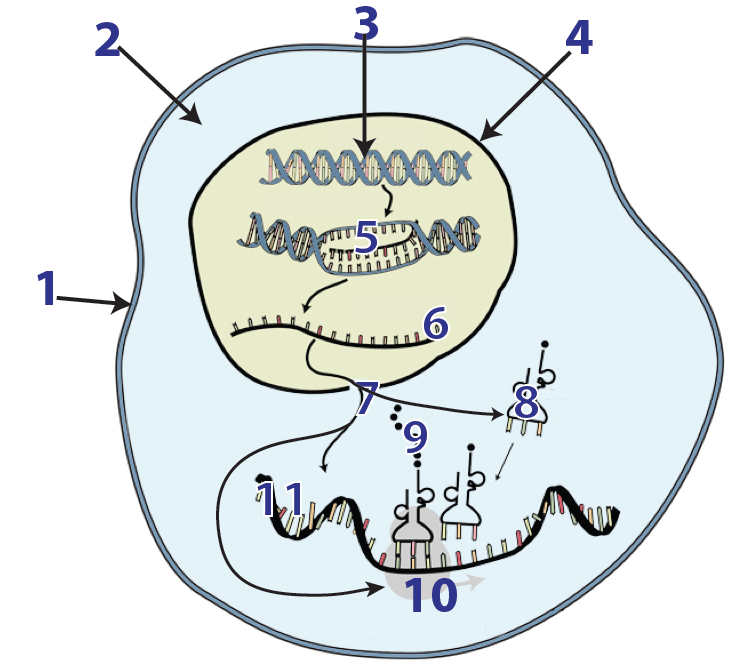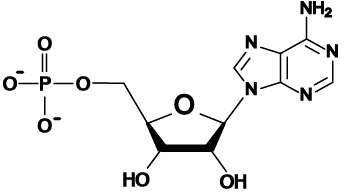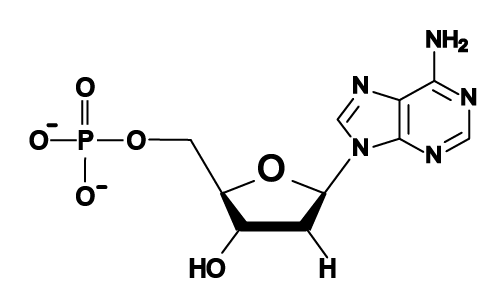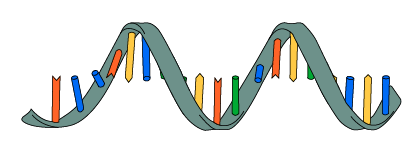1. Review: Transcription and Translation
In a previous tutorial about DNA, we looked at the central dogma of molecular genetics: DNA makes RNA makes protein. To review, label the diagram below.
[qwiz qrecord_id=”sciencemusicvideosMeister1961-Central Dogma Review (HS)”]
[h]DNA makes RNA makes Protein
[q labels = “top”]
[l]RNA
[fx] No, that’s not correct. Please try again.
[f*] Great!
[l]translation of RNA to protein
[fx] No, that’s not correct. Please try again.
[f*] Correct!
[l]DNA
[fx] No, that’s not correct. Please try again.
[f*] Excellent!
[l]cell membrane
[fx] No. Please try again.
[f*] Excellent!
[l]cytoplasm
[fx] No, that’s not correct. Please try again.
[f*] Good!
[l]protein
[fx] No, that’s not correct. Please try again.
[f*] Good!
[l]transcription of DNA to RNA
[fx] No, that’s not correct. Please try again.
[f*] Great!
[l]nuclear membrane
[fx] No, that’s not correct. Please try again.
[f*] Excellent!
[/qwiz]
2. Three types of RNA – mRNA, rRNA, and tRNA – are involved in transcription and translation
In this series of tutorials, we’re going to delve into how cells direct the synthesis RNA and protein from DNA instructions. As you just indicated in the diagram above, key parts of this process include
- transcription of RNA from DNA,
- the movement of RNA from the nucleus to the cytoplasm
- translation, by ribosomes, of RNA messages into protein.
In what follows, we’ll see that three types of RNA are involved in this process. Let’s start by looking at the diagram below.
 Notice that it’s very similar to what you labeled above. The cell membrane is at 1. The cytoplasm is at 2. The nuclear membrane is at 4.
Notice that it’s very similar to what you labeled above. The cell membrane is at 1. The cytoplasm is at 2. The nuclear membrane is at 4.
DNA (3) gets transcribed (5) into RNA (6). The RNA exits the nucleus through a nuclear pore (7).
Three types of RNA get transcribed:
- Messenger RNA, or mRNA (11) delivers messages to a ribosome (10).
- The ribosome (10) is made up of protein and a second type of RNA, ribosomal RNA (rRNA),
- A third type of RNA, transfer RNA (tRNA) is shown at number 8. Transfer RNA’s job is to bring amino acids to the ribosome, where they are assembled into proteins (9).
[qwiz qrecord_id=”sciencemusicvideosMeister1961-Three types of RNA (HS)”]
[h]Three Types of RNA are involved in transcription and translation
[q] The type of RNA that brings amino acids to a ribosome during protein synthesis is
[c]bVJOQQ==[Qq]
[c]dFJO QQ==[Qq]
[c]clJOQQ==[Qq]
[f]Tm8uIG1STkEgaXMgbWVzc2VuZ2VyIFJOQS4gSXQgc2VydmVzIGFzIGEgY29kZWQgbWVzc2FnZSwgdGVsbGluZyBhIHJpYm9zb21lIHdoYXQgcHJvdGVpbiB0byBtYWtlLg==[Qq]
[f]WWVzLiB0Uk5BIGlzIHRyYW5zZmVyIFJOQS4gSXQgYnJpbmdzIGFtaW5vIGFjaWRzIHRvIGEgcmlib3NvbWUgZHVyaW5nIHByb3RlaW4gc3ludGhlc2lzLg==[Qq]
[f]Tm8uIHJSTkEgaXMgcmlib3NvbWFswqBSTkEuIEl0IG1ha2VzIHVwIHRoZSByaWJvc29tZS4=
Cg==[Qq]
[q labels = “top”]
[l]DNA
[fx] No. Please try again.
[f*] Great!
[l]cell membrane
[fx] No. Please try again.
[f*] Good!
[l]nuclear membrane
[fx] No, that’s not correct. Please try again.
[f*] Excellent!
[l]cytoplasm
[fx] No. Please try again.
[f*] Correct!
[l]mRNA
[fx] No, that’s not correct. Please try again.
[f*] Excellent!
[l]tRNA
[fx] No. Please try again.
[f*] Correct!
[l]RNA
[fx] No. Please try again.
[f*] Correct!
[l]nuclear pore
[fx] No, that’s not correct. Please try again.
[f*] Great!
[l]protein
[fx] No. Please try again.
[f*] Great!
[l]ribosome/rRNA
[fx] No. Please try again.
[f*] Good!
[l]transcription
[fx] No, that’s not correct. Please try again.
[f*] Correct!
[q]The type of RNA that (along with protein) makes up a a ribosome is
[c]bVJOQQ==[Qq]
[c]dFJOQQ==[Qq]
[c]clJO QQ==[Qq]
[f]Tm8uIG1STkEgaXMgbWVzc2VuZ2VyIFJOQS4gSXQgc2VydmVzIGFzIGEgY29kZWQgbWVzc2FnZSwgdGVsbGluZyBhIHJpYm9zb21lIHdoYXQgcHJvdGVpbiB0byBtYWtlLg==[Qq]
[f]Tm8uIHRSTkEgaXMgdHJhbnNmZXI=IFJOQS4gSXQgYnJpbmdzIGFtaW5vIGFjaWRzIHRvIGEgcmlib3NvbWUgZHVyaW5nIHByb3RlaW4gc3ludGhlc2lzLg==[Qq]
[f]WWVzLiByUk5BIGlzIHJpYm9zb21hbMKgUk5BLiBJdCBtYWtlcyB1cCB0aGUgcmlib3NvbWUu
Cg==[Qq]
[q]In the diagram below, which number is pointing to the ribosome?
[c]OCDCoCDCoCDCoCDCoCA=[Qq][c]OSDCoCDCoCDCoCDCoA==[Qq][c]MTAgwqAgwq AgwqAgwqA=[Qq][c]MTE=
Cg==[Qq][f]Tm8uIDggaXMgdFJOQSAodHJhbnNmZXIgUk5BKQ==[Qq]
[f]Tm8uIDkgaXMgcHJvdGVpbg==[Qq]
[f]WWVzLiAxMCBpbmRpY2F0ZXMgdGhlIHJpYm9zb21lLg==[Qq]
[f]Tm8uIDExIGlzIG1STkEgKG1lc3NlbmdlciBSTkEp
Cg==[Qq]
[q]In the diagram below, which number indicates mRNA?
[c]OCDCoCDCoCDCoCDCoCA=[Qq][c]OSDCoCDCoCDCoCDCoA==[Qq][c]MTAgwqAg[Qq][c]MT E=
Cg==[Qq][f]Tm8uIDggaXMgdFJOQSAodHJhbnNmZXIgUk5BKQ==[Qq]
[f]Tm8uIDkgaXMgcHJvdGVpbg==[Qq]
[f]Tm8uIDEwIGluZGljYXRlcyB0aGUgcmlib3NvbWUu[Qq]
[f]WWVzLiAxMSBpcyBtUk5BIChtZXNzZW5nZXIgUk5BKQ==
Cg==[Qq]
[q]In the diagram below, which number indicates protein?
[c]OCDCoCDCoCDCoCDCoCA=[Qq][c]OSDCoCDCoC DCoCDCoA==[Qq][c]MTAgwqAgwqAgwqA=[Qq][c]MTE=
Cg==[Qq][f]Tm8uIDggaXMgdFJOQSAodHJhbnNmZXIgUk5BKQ==[Qq]
[f]WWVzLiA5IGlzIHByb3RlaW4uIFJlbWVtYmVyIHRoYXQgcHJvdGVpbnMgYXJlIHBvbHltZXJzIG9mIGFtaW5vIGFjaWRzLiBUaGUgdFJOQSB0aGF0IHRoZSBwcm90ZWluIGlzIGF0dGFjaGVkIHRvIGp1c3QgYnJvdWdodCBhbiBhbWlubyBhY2lkIHRvIHRoZSByaWJvc29tZSBmb3IgcHJvdGVpbiBzeW50aGVzaXMu[Qq]
[f]Tm8uIDEwIGluZGljYXRlcyB0aGUgcmlib3NvbWUu[Qq]
[f]Tm8uIDExIGlzIG1STkEgKG1lc3NlbmdlciBSTkEp
Cg==[Qq]
[q]Which type of RNA is a coded message from DNA, telling a ribosome what protein to make?
[c]bVJO QQ==[Qq]
[c]dFJOQQ==[Qq]
[c]clJOQQ==[Qq]
[f]WWVzLiBtUk5BIGlzIA==bWVzc2VuZ2VyIFJOQS4gSXQgc2VydmVzIGFzIGEgY29kZWQgbWVzc2FnZSwgdGVsbGluZyBhIHJpYm9zb21lIHdoYXQgcHJvdGVpbiB0byBtYWtlLg==[Qq]
[f]Tm8uIHRSTkEgaXMgdHJhbnNmZXI=IFJOQS4gSXQgYnJpbmdzIGFtaW5vIGFjaWRzIHRvIGEgcmlib3NvbWUgZHVyaW5nIHByb3RlaW4gc3ludGhlc2lzLg==[Qq]
[f]Tm8uIHJSTkEgaXMgcmlib3NvbWFswqBSTkEuIEl0IG1ha2VzIHVwIHRoZSByaWJvc29tZS4=
Cg==wqA=
[Qq][x]
[restart]
[/qwiz]
3. RNA
RNA is an acronym for ribonucleic acid.
Here are two similarities between RNA and DNA.
- Like DNA, RNA is a nucleic acid polymer, composed of repeating nucleotide monomers.
- In both DNA and RNA, the sequence of monomers encodes genetic information.
However, there are also a few differences between DNA and RNA.
1. DNA and RNA are built out of different sets of monomers.
Take a good look at the two structural formulas below. Reason your way to an answer.
[qwiz qrecord_id=”sciencemusicvideosMeister1961-ribonucleotide v. deoxyribonucleotide (HS)”]
[q labels = “top”]
| ________________________ | ______________________ |
| The sugar has two -OH (hydroxyl) groups. | The sugar has one -OH (hydroxyl), and one H. |
[l]deoxyribonucleotide
[fx] No. Please try again.
[f*] Correct!
[l]ribonucleotide
[fx] No, that’s not correct. Please try again.
[f*] Great!
[/qwiz]
The sugar in an RNA nucleotide is ribose, instead of deoxyribose.
Look at the diagram and caption below to see the difference.
That means that the monomers of DNA and RNA are different. DNA monomers are deoxyribonucleotides. RNA monomers are ribonucleotides. You can’t build DNA out of RNA monomers, and vice versa.
| ribonucleotide with adenine | deoxyribonucleotide with adenine |
 |
 |
| The sugar, ribose, has two -OH (hydroxyl) groups. | The sugar, deoxyribose, has one -OH (hydroxyl), and one H. |
2. RNA is single stranded (whereas DNA is double stranded).

3. In the nucleotides that make up RNA, three of the bases are the same as in DNA (adenine, cytosine, and guanine). However, the fourth RNA base is uracil (instead of thymine).
4. The base pairing rules are different. Despite the fact that RNA is single stranded, some base pairing happens within RNA molecules. There’s also base pairing between mRNA and tRNA, and between DNA and RNA.
Within RNA, or between RNAs, the base pairing rules are
- Adenine binds with uracil
- guanine binds with cytosine
When DNA is transcribed into RNA, the base pairing rules are
- adenine (in DNA) binds with uracil (in RNA)
- Thymine (in DNA) binds with adenine (in RNA)
- Guanine (in DNA or RNA) binds with cytosine (in DNA or RNA)
A little practice will clarify these relationships:
[qwiz qrecord_id=”sciencemusicvideosMeister1961-RNA Base Pairing (HS)”]
[h]RNA Base pairing practice
[q labels = “top”]
| RNA sequence |
A |
U |
A |
G |
C |
C |
G |
U |
A |
| Matching nucleotide in RNA | ___ | ___ | ___ | ___ | ___ | ___ | ___ | ___ | __ |
[l]A
[fx] No, that’s not correct. Please try again.
[f*] Correct!
[l]U
[fx] No, that’s not correct. Please try again.
[f*] Excellent!
[l]C
[fx] No. Please try again.
[f*] Good!
[l]G
[fx] No, that’s not correct. Please try again.
[f*] Great!
[!!!]DNA TO RNA Base pairing practice [//!]
[q labels = “top”]
| DNA Sequence |
A |
T |
G |
G |
C |
A |
G |
T |
A |
| Matching nucleotides in RNA | ___ | ___ | ___ | ___ | ___ | ___ | ___ | ___ | ___ |
[l]A
[fx] No, that’s not correct. Please try again.
[f*] Excellent!
[l]U
[fx] No, that’s not correct. Please try again.
[f*] Excellent!
[l]C
[fx] No, that’s not correct. Please try again.
[f*] Excellent!
[l]G
[fx] No. Please try again.
[f*] Excellent!
[x]
[restart]
[/qwiz]
4. Reading: The process of transcription
You already know that DNA gets transcribed into RNA. But how does that work?
DNA codes for genes. A gene is typically defined as a unit of heredity. But since we’re looking at DNA, RNA, and Protein, we can think of this a little differently. Think of a gene as a sequence of DNA that gets transcribed into RNA, or which gets translated into protein, (or both).
Here’s how a gene is organized.

- The part that’s labeled GENE is the DNA that’s going to be transcribed.
- The promoter is DNA before the gene that acts a a signal. It tells a variety of proteins and enzymes that a gene is about to start.
- The template strand is the strand that is going to be transcribed.
Transcription is carried out by a team of enzymes and proteins. The key enzyme in this process is RNA polymerase. In the diagram below, RNA polymerase is represented as RNAP.

Transcription starts with RNA polymerase binding at the promoter.
After binding, RNA polymerase moves down the length of the gene.
As it does, it forces the double stranded DNA apart. This allows free-floating RNA nucleotides that are in the nucleus to bind with the exposed DNA bases. Keep in mind that RNA polymerase doesn’t know which base should come next. That information is in the template strand.
Once the correct RNA nucleotide is in place, RNA polymerase creates a sugar-phosphate bond between the new nucleotide and the one before it. The blue strand that’s attached to the template strand above is the new RNA.
Here’s a closeup depiction showing RNA polymerase, free RNA nucleotides, and the template strand.

Pair up the template strand below with free floating nucleotides.It’s exactly what you did above, except that now you have the context for it.
[qwiz qrecord_id=”sciencemusicvideosMeister1961-More RNA Base Pairing (HS)”]
[h]RNA Base Pairing Practice
[q labels = “top”]
| Transcribed RNA | ___ | ___ | ___ | ___ | ___ | ___ | ___ | ___ | ___ |
| Template strand of DNA |
T |
T |
A |
C |
G |
T |
C |
G |
G |
[l]A
[fx] No. Please try again.
[f*] Good!
[l]G
[fx] No, that’s not correct. Please try again.
[f*] Correct!
[l]U
[fx] No. Please try again.
[f*] Great!
[l]C
[fx] No, that’s not correct. Please try again.
[f*] Great!
[x]
[restart]
[/qwiz]
When the RNA polymerase reaches the end of the gene, transcription ends. The newly transcribed RNA is released, and the RNA polymerase detaches from the DNA
Here’s a quick summary of what happens in transcription:
- RNA polymerase binds at a promoter for a gene (a segment of DNA that codes for a protein or RNA).
- By partially opening up the DNA, RNA polymerase allows RNA nucleotides to bind with the template strand.
- When the right RNA nucleotide is in place, RNA polymerase catalyzes a sugar-phosphate bond between the new RNA nucleotide and the one before it on the growing RNA strand.
- When RNA polymerase gets to the end of the gene, it detaches from the DNA. The RNA transcript is released.
5. Checking Understanding: Transcription Quiz
[qwiz style = “border: 3px solid black; ” random = “false” qrecord_id=”sciencemusicvideosMeister1961-Transcription Quiz (HS)”]
[h] Quiz: Transcription
[i] Here’s how the quiz works:
- Each question is multiple choice or fill-in-the-blanks, but the entire quiz is like a series of flashcards.
- If you get the question right, it comes off the deck.
- If you get the question wrong, it goes to the bottom of the deck, so you can try it again.
[q] If a DNA template strand is ATTGCATCGATT, then the RNA transcribed from this strand will be [textentry suggest=”false”]
[c]IFVBQUNHVU FHQ1VBQQ==[Qq]
[f]IEV4Y2VsbGVudCEgSWYgYSBETkEgdGVtcGxhdGUgaXMgQVRUR0NBVENHQVRULCB0aGUgUk5BIHRyYW5zY3JpcHQgd2lsbCBiZSBVQUFDR1VBR0NVQUEu[Qq]
[c]IEVudGVyIHdvcmQ=[Qq]
[c]ICo=[Qq]
[f]IE5vLiBSZW1lbWJlciB0aGUgcnVsZXMgZm9yIHRyYW5zY3JpcHRpb24gb2YgRE5BIHRvIFJOQS4gQSBpcyB0cmFuc2NyaWJlZCB0byBVOyBUIHRvIEE7IEcgdG8gQzsgYW5kIEMgdG8gRy4=[Qq]
[q multiple_choice=”true”] In a gene, the strand which gets transcribed into RNA is called the
[c]IHRlbXBsYXRl IHN0cmFuZA==[Qq]
[f]IFllcy7CoFRoZSBETkEgc3RyYW5kIHRoYXQgZ2V0cyB0cmFuc2NyaWJlZCBpbnRvIFJOQSBpcyBjYWxsZWQgdGhlIA==dGVtcGxhdGUgc3RyYW5kLg==[Qq]
[c]IHRyYW5zY3JpcHRpb24gdW5pdA==[Qq]
[f]IE5vLsKgVGhlIHRlcm0gdHJhbnNjcmlwdGlvbiB1bml0IG1lYW5zIGHCoA==JiM4MjIwO2HCoA==[Qq]stretch of DNA being transcribed into an RNA molecule” (biology-online.org). It’s roughly equivalent to “gene.”
[c]IHByb21vdGVy[Qq]
[f]IE5vLsKgVGhlIHByb21vdGVyIGlzIGEgc2VxdWVuY2Ugb2YgRE5BIHdoaWNoIGFjdHMgYSBzaWduYWwsIHRlbGxpbmcgUk5BIHBvbHltZXJhc2Ugd2hlcmUgdG8gYmluZC4=
Cg==[Qq]
[q multiple_choice=”true”] The sequence of DNA which acts a signal, telling RNA polymerase where to bind, is called the
[c]IFJOQSBiaW5kaW5nIHNpdGU=[Qq]
[f]IE5vLiBJdCBpcyBjZXJ0YWlubHkgYW4gUk5BIGJpbmRpbmcgc2l0ZSwgYnV0IHRoZXJlJiM4MjE3O3MgYSBtb3JlIHNwZWNpZmljIHRlcm0u[Qq]
[c]IGdlbmUgaW5kaWNhdG9yIHNlcXVlbmNl[Qq]
[f]IE5vLiBJdCBpcyBhIHNlcXVlbmNlIHRoYXQgaW5kaWNhdGVzIHRoZSBzdGFydCBvZiBhIGdlbmUsIGJ1dMKgdGhlcmUmIzgyMTc7cyBhIG1vcmUgc3BlY2lmaWMgKGFuZCBhY2NlcHRlZCkgdGVybS4=[Qq]
[c]IHByb2 1vdGVy[Qq]
[f]IFllcy7CoFRoZSBzZXF1ZW5jZSBvZiBETkEgd2hpY2ggYWN0cyBhIHNpZ25hbCwgdGVsbGluZyBSTkEgcG9seW1lcmFzZSB3aGVyZSB0byBiaW5kLCBpcyBjYWxsZWQgdGhlIA==cHJvbW90ZXI=Lg==
Cg==[Qq]
[q multiple_choice=”true”] A sequence of DNA that gets transcribed into RNA, or which gets translated into protein, (or both), is a
[c]IHRlbXBsYXRl[Qq]
[f]IE5vLiBBIHRlbXBsYXRlIGlzIGEgbW9yZSBnZW5lcmFsIGNvbmNlcHQuIFRoZSB2ZXJzaW9uIDIuMTEgb2YgdGhlIEFwcGxlIERpY3Rpb25hcnkgZGVmaW5lcyA=dGVtcGxhdGU=IGFzwqAmIzgyMjA7YcKgbW9sZWN1bGUgdGhhdCBhY3RzIGFzIGEgcGF0dGVybiBmb3IgdGhlIHNlcXVlbmNlIG9mIGFzc2VtYmx5IG9mIGEgcHJvdGVpbiwgbnVjbGVpYyBhY2lkLCBvciBvdGhlciBsYXJnZSBtb2xlY3VsZS4mIzgyMjE7IFRoZSB0ZXJtIHlvdSYjODIxNztyZSBsb29raW5nIGZvciBjYW4gYWxzbyBiZSBkZWZpbmVkIGFzIGEgdW5pdCBvZiBoZXJlZGl0eQ==Lg==[Qq]
[c]IGdl bmU=[Qq]
[f]IFllcy4gQSBnZW5lIGlzwqBhwqA=c2VxdWVuY2Ugb2YgRE5BIHRoYXQgZ2V0cyB0cmFuc2NyaWJlZCBpbnRvIFJOQSwgb3Igd2hpY2ggZ2V0cyB0cmFuc2xhdGVkIGludG8gcHJvdGVpbiwgKG9yIGJvdGgpLg==[Qq]
[c]IHRyYW5zY3JpcHRpb24gZmFjdG9y[Qq]
[f]IE5vLiBBIHRyYW5zY3JpcHRpb24gZmFjdG9yIGlzwqA=cHJvdGVpbg==IHRoYXQgYmluZHMgdG8gc3BlY2lmaWMgRE5BIHNlcXVlbmNlcw==LCB0aGVyZWJ5IGNvbnRyb2xsaW5nIHRoZSByYXRlIG9mIA==[Qq]transcription of genetic information from DNA to messenger RNA (wikipedia). The term you’re looking for can also be defined as a unit of heredity.
[q multiple_choice=”true”] In the diagram below, RNA polymerase is indicated by number
[c]IDEgwqAgwqAgwqAgwqAgwqDigIPigIM=[Qq][c]IDIgwqAgwqAgwqAgwqAgwqDigIPigIM=[Qq][c]IMKgMyDCoCDCoCDCoC DCoCDCoOKAg+KAgw==[Qq][c]IMKgNCDCoCDCoCDCoCDCoCDCoOKAg+KAgw==[Qq][c]IMKgNQ==[Qq][f]IE5vLiBOdW1iZXIgMSBpbmRpY2F0ZXMgdGhlIHByb21vdGVyLg==
Cg==[Qq][f]IE5vLiBOdW1iZXIgMiBpcyB0aGUgUk5BIHRyYW5zY3JpcHQu[Qq]
[f]IFllcy4gTnVtYmVyIDMgaXMgUk5BIHBvbHltZXJhc2Uu[Qq]
[f]IE5vLiBOdW1iZXIgNCBpcyB0aGUgZ2VuZS4=[Qq]
[f]IE5vLiBOdW1iZXIgNcKgaXMgdGhlIHRlbXBsYXRlIHN0cmFuZC4=
Cg==[Qq]
[q multiple_choice=”true”] In the diagram below, the RNA transcript is indicated by number
[c]IDEgwqAgwqAgwqAgwqAgwqDigIPigIM=[Qq][c]IDIgwqAgwqAgwqAg wqAgwqDigIPigIM=[Qq][c]IMKgMyDCoCDCoCDCoCDCoCDCoOKAg+KAgw==[Qq][c]IMKgNCDCoCDCoCDCoCDCoCDCoOKAg+KAgw==[Qq][c]IMKgNQ==
Cg==[Qq][f]IE5vLiBOdW1iZXIgMSBpbmRpY2F0ZXMgdGhlIHByb21vdGVyLg==[Qq]
[f]IFllcy4gTnVtYmVyIDIgaXMgdGhlIFJOQSB0cmFuc2NyaXB0Lg==[Qq]
[f]IE5vLiBOdW1iZXIgMyBpcyBSTkEgcG9seW1lcmFzZS4=[Qq]
[f]IE5vLiBOdW1iZXIgNCBpcyB0aGUgZ2VuZS4=[Qq]
[f]IE5vLiBOdW1iZXIgNSBpcyB0aGUgdGVtcGxhdGUgc3RyYW5kLg==
Cg==[Qq]
[q multiple_choice=”true”] The function of RNA polymerase is to
[c]IGluZGljYXRlIHdoZXJlIHRyYW5zY3JpcHRpb24gc2hvdWxkIHN0YXJ0Lg==[Qq]
[f]IE5vLsKgSW5kaWNhdGluZyB3aGVyZSB0cmFuc2NyaXB0aW9uIHN0YXJ0cyBpcyB0aGUgZnVuY3Rpb24gb2YgdGhlIHByb21vdGVyLg==[Qq]
[c]IHByb3ZpZGUgdGhlIGluZm9ybWF0aW9uIGluZGljYXRpbmcgdGhlIGNvcnJlY3Qgc2VxdWVuY2Ugb2YgbnVjbGVvdGlkZXMgaW4gYW4gUk5BIHRyYW5zY3JpcHQ=[Qq]
[f]IE5vLsKgUHJvdmlkaW5nIHRoZSBpbmZvcm1hdGlvbiBpbmRpY2F0aW5nIHRoZSBjb3JyZWN0IHNlcXVlbmNlIG9mIG51Y2xlb3RpZGVzIGluIGFuIFJOQSB0cmFuc2NyaXB0IGlzIHRoZSBmdW5jdGlvbiBvZiB0aGUgdGVtcGxhdGUgc3RyYW5kLg==[Qq]
[c]IGNyZWF0ZSBzdWdhci1waG9zcGhhdGUgYm9uZHMgYmV0d2Vlbi BvbmUgUk5BIG51Y2xlb3RpZGUgYW5kIHRoZSBuZXh0IG9uZS4=[Qq]
[f]IFllcy4gQ3JlYXRpbmcgc3VnYXItcGhvc3BoYXRlIGJvbmRzIGJldHdlZW4gb25lIFJOQSBudWNsZW90aWRlIGFuZCB0aGUgbmV4dCBvbmUgaXMgdGhlIGZ1bmN0aW9uIG9mIFJOQSBwb2x5bWVyYXNlLg==
Cg==[Qq]
[q multiple_choice=”true”] In the diagram below, the gene is indicated by number
[c]IDEgwqAgwqAgwqAgwqAgwqDigIPigIM=[Qq][c]IDIgwqAgwqAgwqAgwqAgwqDigIPigIM=[Qq][c]IMKgMyDCoCDCoCDCoCDCoCDCoOKAg+KAgw==[Qq][c]IMKgNCDCoCDCoCDCoC DCoCDCoOKAg+KAgw==[Qq][c]IMKgNQ==[Qq][f]IE5vLiBOdW1iZXIgMSBpbmRpY2F0ZXMgdGhlIHByb21vdGVyLg==
Cg==[Qq][f]IE5vLiBOdW1iZXIgMiBpcyB0aGUgUk5BIHRyYW5zY3JpcHQu[Qq]
[f]IE5vLiBOdW1iZXIgMyBpcyBSTkEgcG9seW1lcmFzZS4=[Qq]
[f]IFllcy4gTnVtYmVyIDQgaXMgdGhlIGdlbmUu[Qq]
[f]IE5vLiBOdW1iZXIgNcKgaXMgdGhlIHRlbXBsYXRlIHN0cmFuZC4=
Cg==[Qq]
[q multiple_choice=”true”] In RNA, the sugar-phosphate bond between adjacent nucleotides (nucleotides that are next to one another in the same strand) is a
[c]IGh5ZHJvZ2VuIGJvbmQ=[Qq]
[f]IE5vLiBEdXJpbmcgdHJhbnNjcmlwdGlvbiwgaHlkcm9nZW4gYm9uZHMgZm9ybSB3aGVuIFJOQSBudWNsZW90aWRlcyBib25kIHdpdGggY29tcGxlbWVudGFyeSBudWNsZW90aWRlcyBvbiB0aGUgdGVtcGxhdGUgc3RyYW5kLg==[Qq]
[c]IGNvdmFsZW 50IGJvbmQ=[Qq]
[f]IFllcy7CoFN1Z2FyLXBob3NwaGF0ZSBib25kcyBhcmUgY292YWxlbnQgYm9uZHMu[Qq]
[c]IGlvbmljIGJvbmQ=[Qq]
[f]IE5vLsKgVGhlIGJvbmQgYmV0d2VlbiBhZGphY2VudCBudWNsZW90aWRlcyBpcyB0aGUgb25lIHRoYXQgaW52b2x2ZXMgc2hhcmluZyBlbGVjdHJvbnMuIFdoaWNoIHR5cGUgb2YgYm9uZCBpcyB0aGF0Pw==
Cg==[Qq]
[q multiple_choice=”true”] In the diagram below, the template strand is indicated by number
[c]IDEgwqAgwqAgwqAgwqAgwqDigIPigIM=[Qq][c]IDIgwqAgwqAgwqAgwqAgwqDigIPigIM=[Qq][c]IMKgMyDCoCDCoCDCoCDCoCDCoOKAg+KAgw==[Qq][c]IMKgNCDCoCDCoCDCoCDCoCDCoOKAg+KAgw==[Qq][c]IMKg NQ==[Qq][f]IE5vLiBOdW1iZXIgMSBpbmRpY2F0ZXMgdGhlIHByb21vdGVyLg==
Cg==[Qq][f]IE5vLiBOdW1iZXIgMiBpcyB0aGUgUk5BIHRyYW5zY3JpcHQu[Qq]
[f]IE5vLiBOdW1iZXIgMyBpcyBSTkEgcG9seW1lcmFzZS4=[Qq]
[f]IE5vLiBOdW1iZXIgNCBpcyB0aGUgZ2VuZS4=[Qq]
[f]IFllcy4gTnVtYmVyIDXCoGlzIHRoZSB0ZW1wbGF0ZSBzdHJhbmQu
Cg==[Qq]
[q multiple_choice=”true”] During transcription, the temporary bond that forms between DNA nucleotides on the template strand and RNA nucleotides on the growing RNA strand is a
[c]IGh5ZHJvZ2 VuIGJvbmQ=[Qq]
[f]IFllcy4gRHVyaW5nIHRyYW5zY3JpcHRpb24sIGh5ZHJvZ2VuIGJvbmRzIGZvcm0gd2hlbiBSTkEgbnVjbGVvdGlkZXMgYm9uZCB3aXRoIGNvbXBsZW1lbnRhcnkgbnVjbGVvdGlkZXMgb24gdGhlIHRlbXBsYXRlIHN0cmFuZC4=[Qq]
[c]IGNvdmFsZW50IGJvbmQ=[Qq]
[f]IE5vLiBDb3ZhbGVudCBib25kcyBhcmUgd2hhdCBob2xkIGVhY2ggc3RyYW5kIG9mIFJOQSAob3IgRE5BKSB0b2dldGhlci4gVGhlIGJvbmQgYmV0d2VlbiBjb21wbGVtZW50YXJ5IG51Y2xlb3RpZGVzIGlzIGEgbXVjaCB3ZWFrZXIgYm9uZC4gSXQmIzgyMTc7cyB0aGUgc2FtZSBraW5kIG9mIGJvbmQgdGhhdCBvY2N1cnMgYmV0d2VlbiB3YXRlciBtb2xlY3VsZXMu[Qq]
[c]IGlvbmljIGJvbmQ=[Qq]
[f]IE5vLsKgVGhlIHRlbXBvcmFyeSBib25kIHRoYXQgZm9ybXMgYmV0d2VlbiBETkEgbnVjbGVvdGlkZXMgb24gdGhlIHRlbXBsYXRlIHN0cmFuZCBhbmQgUk5BIG51Y2xlb3RpZGVzIG9uIHRoZSBncm93aW5nIFJOQSBzdHJhbmQgaXMgbXVjaCB3ZWFrZXIgdGhhbiBhbiBpb25pYyBib25kLiBJdCYjODIxNztzIGJhc2VkIG9uIHBhcnRpYWwgbmVnYXRpdmUgb3IgcG9zaXRpdmUgY2hhcmdlcywgYW5kIGl0JiM4MjE3O3MgdGhlIHNhbWUga2luZCBvZiBib25kIHRoYXQgb2NjdXJzIGJldHdlZW4gd2F0ZXIgbW9sZWN1bGVzLg==
Cg==[Qq]
[q multiple_choice=”true”] In the diagram below, the promoter is indicated by number
[c]IDEgwqAgwqAgwqAg wqAgwqDigIPigIM=[Qq][c]IDIgwqAgwqAgwqAgwqAgwqDigIPigIM=[Qq][c]IMKgMyDCoCDCoCDCoCDCoCDCoOKAg+KAgw==[Qq][c]IMKgNCDCoCDCoCDCoCDCoCDCoOKAg+KAgw==[Qq][c]IMKgNQ==[Qq][f]IFllcy4gTnVtYmVyIDEgaW5kaWNhdGVzIHRoZSBwcm9tb3Rlci4=
Cg==[Qq][f]IE5vLiBOdW1iZXIgMiBpcyB0aGUgUk5BIHRyYW5zY3JpcHQu[Qq]
[f]IE5vLiBOdW1iZXIgMyBpcyBSTkEgcG9seW1lcmFzZS4=[Qq]
[f]IE5vLiBOdW1iZXIgNCBpcyB0aGUgZ2VuZS4=[Qq]
[f]IE5vLiBOdW1iZXIgNcKgaXMgdGhlIHRlbXBsYXRlIHN0cmFuZC4=
Cg==[Qq]
[q] The monomers of protein are _____ acids
[hangman]
[c]IGFtaW5v[Qq]
[f]IFBlcmZlY3QhIFRoZSBtb25vbWVycyBvZiBwcm90ZWluIGFyZSA=YW1pbm8=IGFjaWRz
Cg==[Qq]
[q] Transcription is making RNA from a ____ template
[hangman]
[c]IEROQQ==[Qq]
[f]IEdyZWF0IGpvYiEgVHJhbnNjcmlwdGlvbiBpcyBtYWtpbmcgUk5BIGZyb20gYSA=RE5BIHRlbXBsYXRl
Cg==[Qq]
[q] Replication is making ____ from DNA
[hangman]
[c]IEROQQ==[Qq]
[f]IE5pY2UhIFJlcGxpY2F0aW9uIGlzIG1ha2luZyA=RE5BIGZyb20gRE5B
Cg==[Qq]
[q] Translation is making
[hangman]
[c]IHByb3RlaW4=[Qq]
[f]IEF3ZXNvbWUhIFRyYW5zbGF0aW9uIGlzIG1ha2luZyA=cHJvdGVpbg==
Cg==[Qq]
[q] The central ______ of molecular genetics is that DNA makes RNA makes protein
[hangman]
[c]IGRvZ21h[Qq]
[f]IFllcyEgVGhlIGNlbnRyYWwgZG9nbWE=IG9mIG1vbGVjdWxhciBnZW5ldGljcyBpcyB0aGF0IEROQSBtYWtlcyBSTkEgbWFrZXMgcHJvdGVpbg==
Cg==[Qq]
[q] In eukaryotes, transcription occurs in the
[hangman]
[c]IG51Y2xldXM=[Qq]
[f]IFBlcmZlY3QhIEluIGV1a2FyeW90ZXMsIHRyYW5zY3JpcHRpb24gb2NjdXJzIGluIHRoZSA=bnVjbGV1cw==
Cg==[Qq]
[q] The sugar in DNA is
[hangman]
[c]IGRlb3h5cmlib3Nl[Qq]
[f]IEdvb2Qgam9iISBUaGUgc3VnYXIgaW4gRE5BIGlzIA==ZGVveHlyaWJvc2U=
Cg==[Qq]
[q] The sugar in RNA is
[hangman]
[c]IHJpYm9zZQ==[Qq]
[f]IENvcnJlY3QhIFRoZSBzdWdhciBpbiBSTkEgaXMgcmlib3Nl
Cg==[Qq]
[q] Whereas DNA has the nitrogenous base thymine, RNA has
[hangman]
[c]IHVyYWNpbA==[Qq]
[f]IEV4Y2VsbGVudCE=[Qq]
[q] In RNA, cytosine bonds with
[hangman]
[c]IGd1YW5pbmU=[Qq]
[f]IFllcyEgSW4gUk5BLCBjeXRvc2luZSBib25kcyB3aXRoIA==Z3VhbmluZQ==
Cg==[Qq]
[q] In RNA, adenine bonds with
[hangman]
[c]IHVyYWNpbA==[Qq]
[f]IEF3ZXNvbWUhIEluIFJOQSwgYWRlbmluZSBib25kcyB3aXRoIA==dXJhY2ls
Cg==[Qq]
[q] Review: The monomers of nucleic acids are
[hangman]
[c]IG51Y2xlb3RpZGVz[Qq]
[f]IEdyZWF0ISBUaGUgbW9ub21lcnMgb2YgbnVjbGVpYyBhY2lkcyBhcmUgbnVjbGVvdGlkZXM=
Cg==[Qq]
[q] The three parts of a _________ are sugar, phosphate, nitrogenous base
[hangman]
[c]IG51Y2xlb3RpZGU=[Qq]
[f]IEdlbml1cyEgVGhlIHRocmVlIHBhcnRzIG9mIGEgbnVjbGVvdGlkZQ==IGFyZSBzdWdhciwgcGhvc3BoYXRlLCBuaXRyb2dlbm91cyBiYXNl
Cg==[Qq]
[q] The number of strands in RNA is
[textentry single_char=”true”]
[c]ID E=[Qq]
[f]IENvcnJlY3QhIFRoZSBudW1iZXIgb2Ygc3RyYW5kcyBpbiBSTkEgaXMgMSAob25lKQ==[Qq]
[c]ICo=[Qq]
[f]IE5vLiBSTkEgaXMgYSBzaW5nbGUgc3RyYW5kZWQgbW9sZWN1bGUuIFRoZXJlJiM4MjE3O3MganVzdCBvbmUgc3RyYW5kICgxKS4=
Cg==[Qq]
[q] The type of RNA that makes up ribosomes is _______ RNA
[hangman]
[c]IHJpYm9zb21hbA==[Qq]
[f]IFBlcmZlY3QhIFRoZSB0eXBlIG9mIFJOQSB0aGF0IG1ha2VzIHVwIHJpYm9zb21lcyBpcyA=cmlib3NvbWFsIFJOQQ==
Cg==[Qq]
[q] Review: The enzyme that breaks apart the double helix during replication
[hangman]
[c]IEROQSBoZWxpY2FzZQ==[Qq]
[f]IE5pY2UhIFRoZSBlbnp5bWUgdGhhdCBicmVha3MgYXBhcnQgdGhlIGRvdWJsZSBoZWxpeCBkdXJpbmcgcmVwbGljYXRpb24gaXMgRE5BIGhlbGljYXNl
Cg==[Qq]
[q] The enzyme that connects new RNA nucleotides to a growing strand during transcription is
[hangman]
[c]IFJOQSBwb2x5bWVyYXNl[Qq]
[f]IFllcyEgVGhlIGVuenltZSB0aGF0IGNvbm5lY3RzwqBuZXcgUk5BIG51Y2xlb3RpZGVzIHRvIGEgZ3Jvd2luZyBzdHJhbmQgZHVyaW5nIHRyYW5zY3JpcHRpb24gaXMgUk5BIHBvbHltZXJhc2U=[Qq]
[x]
If you want more practice, please press the restart button below. Otherwise, follow the links below.
[restart]
[/qwiz]
6.Flashcards: RNA and Transcription
If you want more practice, these flashcards are for you. Take your time…
[qdeck qrecord_id=”sciencemusicvideosMeister1961-Transcription Flashcards (HS)”]
[h] Flashcards: RNA and transcription
[i] If you haven’t used a set of flashcards on sciencemusicvideos before, here’s what you need to know.
- Click ‘Check Answer’ to see the answer to each card.
- If you know it, click ‘Got it.”
- If you don’t know it as well as you’d like, click ‘Need more practice,’ and that card will go to the bottom of the deck so you can practice it again.
- ‘Shuffle’ lets you shuffle the deck.
[!]Question X+++++++++[/!]
[q]The monomers of protein are
[textentry]
[a]The monomers of protein are amino acids
[!]Question X+++++++++[/!]
[q]Transcription is
[textentry]
[a]Transcription is making RNA from a DNA template
[!]Question X+++++++++[/!]
[q]Replication is
[textentry]
[a]Replication is making DNA from DNA
[!]Question X+++++++++[/!]
[q]Translation is
[textentry]
[a]Translation is making protein
[!]Question X+++++++++[/!]
[q]The central dogma of molecular genetics is
[textentry]
[a]The central dogma of molecular genetics is DNA makes RNA makes protein
[!]Question X+++++++++[/!]
[q]In eukaryotes, transcription occurs in the
[textentry]
[a]In eukaryotes, transcription occurs in the nucleus
[!]Question X+++++++++[/!]
[q]The sugar in DNA is
[textentry]
[a]The sugar in DNA is deoxyribose
[!]Question X+++++++++[/!]
[q]The sugar in RNA is
[textentry]
[a]The sugar in RNA is ribose
[!]Question X+++++++++[/!]
[q]Whereas DNA has the nitrogenous base thymine, RNA has
[textentry]
[a]Whereas DNA has the nitrogenous base thymine, RNA has uracil
[!]Question X+++++++++[/!]
[q]In RNA, cytosine bonds with
[textentry]
[a]In RNA, cytosine bonds with guanine
[!]Question X+++++++++[/!]
[q]In RNA, adenine bonds with
[textentry]
[a]In RNA, adenine bonds with uracil
[!]Question X+++++++++[/!]
[q]Review: The monomers of nucleic acids are
[textentry]
[a]The monomers of nucleic acids are nucleotides
[!]Question X+++++++++[/!]
[q]The three parts of a nucleotide are
[textentry]
[a]The three parts of a nucleotide are sugar, phosphate, nitrogenous base
[!]Question X+++++++++[/!]
[q]The number of strands in RNA is
[textentry]
[a]The number of strands in RNA is one
[!]Question X+++++++++[/!]
[q]The type of RNA that makes up ribosomes is
[textentry]
[a]The type of RNA that makes up ribosomes is ribosomal RNA
[!]Question X+++++++++[/!]
[q]Review: The enzyme that breaks apart the double helix during replication
[textentry]
[a]The enzyme that breaks apart the double helix during replication is DNA helicase
[!]Question X+++++++++[/!]
[q]The enzyme that connects new RNA nucleotides to a growing strand during transcription is
[textentry]
[a]The enzyme that connects new RNA nucleotides to a growing strand during transcription is RNA polymerase
[!]Question X+++++++++[/!]
[q]If a DNA template strand is ATTGCATCGATT, the RNA transcript will be
[textentry]
[a]If a DNA template strand is ATTGCATCGATT, the RNA transcript will be UAACGUAGCUAA
[x]
If you want more practice, please press the restart button below. Otherwise, follow the links below.
[restart]
[/qdeck]
What’s next?
-
- Learn about The Genetic Code (next high school level tutorial in this series)
- Return to the RNA, Transcription, and Translation (HS Level) Main Menu


